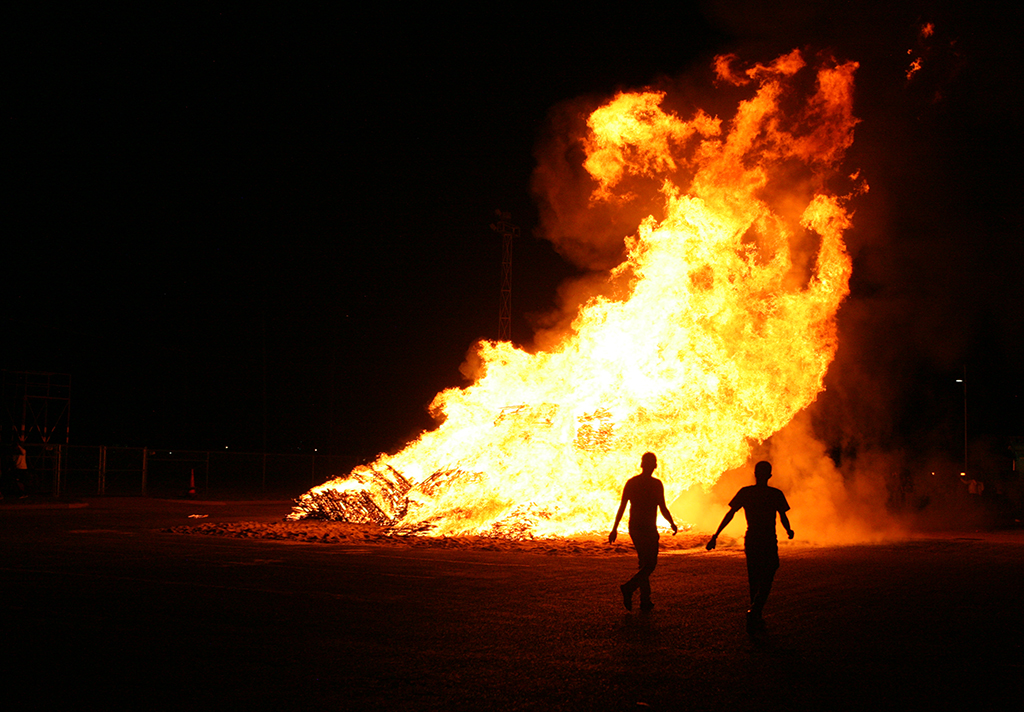Even the homecoming bonfire impacts the environment
October 25, 2017
It’s a chilly night in late October. A crowd gathers around a huge pile of wood with T-shirts from other schools pinned up on the stack. As the crowd grows, soft whispers can be heard about how big and hot the bonfire will be this year. Then, finally, a line of eight flaming torches can be seen in the distance walking towards the pile of wood. As they approach the stack, the torches begin to light it on fire creating a huge uproar of cheers, and a roaring flame.
Dating as far back as the 1960’s, the homecoming bonfire serves as one of the biggest, and most attended events of the week. This event continues to bring students, alumni, and faculty together to show their support for the athletic department as well as watch the finals for the lip sync competition. Another tradition the bonfire brings is students are able to turn in a shirt from another school in exchange for a free MSU shirt, and the shirt they turned in gets burned in the bonfire, along with other donated shirts. At its peak, the bonfire is usually a few stories high in length. However, over the last decade there has been an increase interest in global warming and climate change, making people wonder what damages are these extravagant bonfires creating, and are they even necessary.
Bonfires affect the air quality and raise certain health concerns about air pollutants in smoke such as carbon monoxide, and dioxins, which is harmful for humans and animals to breathe in. Fine particles in smoke, such as the burning of a t shirt, can also aggravate chronic heart and lung disease. The smoke also gets into an individuals’ respiratory system.
Jessica Bates, criminal justice junior, said, “I remember my freshman year I went to the bonfire, and I looked up in the air and I could see all the particles ofT-shirts floating around. The people next to me began coughing, and in the time period that the fire grew and people started moving away from the heat I saw 10 other people coughing too. It was bad.”
In the past, schools such as the University of California, Davis and Texas Tech have cancelled their homecoming bonfires completely. Both of these cancellations were based on how bonfires affect the air quality, and were done in an effort to protect the environment.
Leslee Ponder, alumni association director, said, “The homecoming bonfire is one of the best and longest traditions we have. It helps to bring so many different people together. I know the alumni love to see the traditions they participated in still continue. If the bonfire is ever cancelled I’m sure the alumni would not be pleased, and they would definitely speak up about it.”
Bonfires also contribute to the reduction of the ozone layer. The ozone layer helps to protect from the ultraviolet radiation shining down from the sun. The burning of organic materials seen in bonfires release chloro-methane, which causes 17 percent of the chlorine caused depletion in the ozone layer.
“Unfortunately the smoke the bonfire gives off is very harmful to the environment. Especially us humans, and animals. I know it has harmful impacts to the ozone layer, the air we breathe, and our community,” said Rebecca Dodge, director and associate professor of environmental sciences. She added, “It would be fine if no one else had bonfires, but that isn’t realistic. What has done the harm and will continue the harm is many places that put on huge bonfires have done so for years, and will continue to do so, it’s tradition. Without including small campfires/bonfires, it’s the repetition that does the damage.”
In research done by the Smithsonian, it was found that the particulates and carbon that is released from these huge bonfires are “climate enforcers.” This means that they contribute to climate change in either a short or long term.
Kristi Schulte, director of residence life and housing, said, “The bonfire is one of the best and most attended events homecoming week offers. It’s a great event for students living on, and off campus to come to in order to feel involved with the university. However, the environment needs to be protected. It’s important to the future of our society.”
Another concern people have about these bonfires is that they pollute the air that animals breathe in too. Forest fires happen in the wild, but the air doesn’t become filled with the harmful pollutants that the bonfire smoke contains. Also, this smoke can easily harm children because their respiratory system is still developing so breathing in that smoke can cause diseases such as asthma.
“Before teaching I worked as a respiratory therapist at the Children’s Medical Center in Dallas. I have seen countless number of children as patients who had damage done to them by smoke. These kids are too young to have this kind of damage in their life”, said Jennifer Anderson, respiratory care program chair. She continued to say, “the bonfire is tradition and a fun event to get out and go to for everyone such as families in the Wichita Falls community, not just students that attend school here. Which is why there should be some kind of safety precautions when dealing with all the smoke. Just because we can’t see the smoke go into the night air doesn’t mean it’s not.”

